Butterflies can be seen in every month of the year but the main reproductive cycle spans April through to September. Just six months for all the species in the British Isles to mate and carry on the lepidoptera line.
That doesn't mean that each species has 6 months to mate. Many only have a window of a few days once emerged from their chrysalis before they die.
Some species have one brood a year, others two. Some will overwinter as eggs, some as pupae and a handful as adults. These adults are the ones we would see earlier in the year when they emerge from hibernation when the temperature has reached a sufficient level.
I've seen Red Admiral basking in the warmth of a December sun.
Climate change is having a massive impact on their numbers and they have become the modern day 'Canary in the coalmine' which is quite an ironic title given the recent overuse and impact of fossil fuels since the beginning of the industrial revolution.
In the past 150 years,4 species of Butterfly and 65 species of Moth have become extinct in this country alone. If you compare this with the number of species we have here (59 species of Butterfly,2500 Moth) that is a worrying statistic.
Rather than dwell too much on the negative things, I'll do what I enjoy most and revel in the beauty these enigmatic creatures portray to me and many others.
Given the short months available to witness these little gems in their adult form, and given the even shorter time I have to get out to view them, I make no apologies for indulging in their beauty and wonder. There are so many amazing things to see in the natural world but Butterflies encapsulate the delicate balance of beauty that seems to be heading into the abyss.
I met up with Chris at a new destination. Havant Thicket just North of Portsmouth is a mixture of woodland rides and forest. Popular with dog walkers, horse riders, runners and mad people with binoculars and cameras.
It was the first week in July and we were on the hunt for Purple Emperors once again plus whatever else may happen to cross our path....
Small Skippers were first to show....
Their almost identical cousin, the Essex Skipper with the jet black tipped antennae gave great views low down in the grass.
Up on the ferns, White Admirals arrived wanting their photo taken too.
Ringlets kept a discreet distance as they are known to do along the rides. They can be seen in numbers but constantly flit up and down and land in awkward positions in the undergrowth making photography a little tricky at times.
The sun was rising, the temperature held it's hand which isn't always a guarantee of seeing the Purple Emperor. Contrary to popular belief, if it's too hot for his royal highness they can become quite indolent and not venture too far from the oak canopy.
Large Red Damselflies were quite happy with these conditions ...
Chris and I carried on zig zagging the paths. Our attention switched from trees to bushes to try to capture everything that moved. Gatekeepers were now emerging in a fair few numbers..
Skippers even more so....
Speckled Wood have their niche in the dappled shade and defend their territory with vigor.
We had reached a triangular clearing bordered by tall oak trees bathed in early warm sunlight. In the centre of the triangle was a mixture of bramble and fern. It was alive with Butterflies which was a joy to behold.
The majority were Meadow Brown and although a common species they looked so special in the rejuvenating sun rays.
Not to be outdone, Black and Yellow Longhorn Beetles could be seen on the bramble too.
Carrying on past the triangle we found a Beautiful Demoiselle keeping a discreet distance in the Birch Trees.
We turned again and took a path bathed in sunshine completing a circular route. Immediately another White Admiral flew along the tree line and disappeared into the bushes. It was followed by another smaller specimen. Clearly a male and female doing what nature does, or at least the inclination was there!
Their pairing wasn't consummated on this occasion...
We began more zig zagging towards our starting point. Above us in the trees a Southern Hawker hung surreptitiously before us.
I have had many people question why Dragonflies or even Damselflies for that matter should be seen flying in places not related to water.
They do have a propensity to congregate next to water bodies, the main objective is to mate and lay eggs. They are quite often seen hunting in areas away from these so don't be surprised if you see some in the middle of a forest looking for a meal.
Seemingly at every path we came across a White Admiral. Not the Purple Emperor we had hoped for but not a bad substitute.
Another destination we had thought to visit if we hadn't chosen here was Alice Holt Forest which is a good place for seeing an Emperor. A friend was there at this time and he text me to say he had seen several but only high above the canopy. Purple Emperors are not often seen on the ground so you need the right conditions and a bit of luck thrown in. We were still a little miffed at the news however.
We consoled ourselves in the bounty before us. I hate getting upset over what we might have missed. It's a choice you take and there is beauty in nature all around so I try not to let my ego rule my head...
This Large Skipper made me feel better
so did this Small Skipper
They zip around the flowers as though attached with springs which makes it hard to keep eye contact.
 Once settled when they feed it makes things a whole lot easier. The size of their tongue always astounds me.
Once settled when they feed it makes things a whole lot easier. The size of their tongue always astounds me. More Gatekeepers...
and Large Skippers...
Just when I thought we wouldn't see a Silver Washed Fritillary....
Whenever they fly into view their vibrant colour and direct attitude always takes my breath away, definitely a favourite.
It was now near lunchtime. Our hope of seeing an Emperor was slipping away so we trod a little discomposed back to the car park.
Above us in the trees a Great Spotted Woodpecker perched making it's distinctive 'Kicking' call whilst down below on the umbelifers more Longhorn Beetles were getting a little jiggy....
Part one of the day was done. Where next for part two?
Browndown is a relatively small thriving microcosm heathland not five minutes walk from my front door. It harbours many different species all year round and a place I will concentrate on further in a later blog.
This area has been protected from development for one reason...it is MOD land. Adjacent to the beach this shingle based heath is hugely important for a wide variety of species. Adder, Dartford Warbler, Grayling, Purple Hairstreak, Nightjar, Badger, Roe Deer, Bats, Flowers etc... but for how long?
Chris had wanted to see Grayling and Purple Hairstreak Butterflies so we hot footed it down. The northern area which sits above the shingled beach is open to the public all year round. We began here. The flowers and shrubs were in full glory and the good weather helped us.
Immediately a Common Blue sped around the flowers...
The underside of the wing pattern can be seen from above in this shot giving it a lovely mottled pattern...
The northern part of the heath is a large mixture of grassland interspersed with bramble, buddleia, and bordered with hawthorn.
The Welted Thistle is a popular nectar source for many insects. Marbled White being one case in point...
This individual didn't seem to have it's wings fully formed. It was quite happy feeding on the buddleia however.
As we neared the southern area I knew of a patch where Scabious flowers grew which are a very good source of food. They were being coveted by Six Spot Burnet Moths and Skippers along with Marbled Whites.
As we passed these and hoping to walk onto the southern Browndown area I noticed the red flag flying which meant no entry to the public due to military maneuvers. We were gutted. So near yet so far but we dare not venture any further.
Plan B it was then....
Shatterford in the New Forest is another habitat that can produce all sorts of treasures in all seasons.
The open heath has heather and lots of boggy areas with distant forest harbouring all sorts of delights....
Having parked up in the small pine tree shrouded car park near the railway line, we followed our well known route out into the exposed heathland. Today the weather was kind so being exposed here today meant T-shirt and sun protection instead of raincoat and wind stopper.
The first pools gave up the expected Dragonflies. Keeled Skimmers were the main species here along with an occasional Emperor...the Dragonfly not the Butterfly on this occasion
Their ornate wing structure always amazes me
Even the intrusive cows couldn't stop them from mating...
The heather is a big attraction for a specialist Butterfly. Silver Studded Blue. Diminutive it may be but this is a real stunner and it packs a punch for one so small. I do love these little insects.
Some were clearly nearing the end of their life and looking really tatty but it didn't stop them trying to mate.
The male in blue against the brown female...
In amongst these Chris spotted a slightly larger Butterfly. What we thought was a Brown Argus turned out to be a female Silver Studded Blue on later investigation...these blues can be so difficult to define sometimes. A keen eye, a little knowledge along with a decent reference book helps.
As we slowly walked through the heather clad heath we must have seen easily 500 Silver Studded Blue. I have never seen so many Butterflies in one place. When there is so much doom and decline in statistics these days, it flew in the face of such negativity which made us feel joyous. I couldn't wipe the smile or disbelief off my face!!
We ventured further towards Denny Wood passing more boggy pools that gave up sightings of female Keeled Skimmers...
Upon reaching the wood, Chris and I spied some Spotted Flycatcher feeding from some low bows.
These little birds will soon migrate back to Africa for the winter. I can't believe how soon this season has sped by. It seemed like last weekend when we were greeting them from their long sub Saharan journey to breed here.
Beech trees are one of my favourites. They were still lush green with the the lovely smooth grey bark.
We had passed through the main wooded area and out onto the plain. A Buzzard sat doing what they do best...sitting and doing little.
Down by a large lake which is always habituated by breeding waders a Redshank - so common on late summer through to winter shorelines - called and imitated the nearby Buzzard...
There were Lapwing too but we left them in peace as on the opposite side we discovered some Redstart in the low trees and shrubs. This male was distant but so striking nevertheless..
They are a specialist here in the New Forest and would be leaving soon along with the Flycatchers
We were coming full circle now and heading back out through the wood and towards the car park.
The thick lush green shades took my attention. A male Stonechat sat atop the ferns
Along the path an Emperor hung in the heather nicely for our cameras..
A glance over the shoulder for one last look at Denny Wood and Shatterford. No doubt we shall return in the autumn and winter for some more adventures...
One last stop over on the way home... Fishlake Meadows in Romsey. This place was becoming a a bit of a folly for us. This is an Osprey hotspot. Many sightings here recently. Early migrants with the prospect of more to come. This is a valuable stopping off point for them on their migration south to feed up on some good quality fish.
It corresponded with the news that this nature reserve has now been handed over into the capable hands of the Hampshire and Isle of Wight Wildlife Trust by the local council. With a bit of luck they will provide more viewing areas as this site is severely restricted. It can throw up some real gems. I hope they can do it justice.
After parking the van to walk to the viewing area, this Holly Blue provided some great views sat on the shrubs by the houses.
The viewing platform firstly showed a female Beautiful Demoiselle.
The view is what it is, a flooded area full of dead trees but the wildlife flourishes all around. The Osprey use these trees to sit and eat fish along with Gulls,Cormorants, Hobbys, Marsh Harriers, Ducks and Egrets.
Not forgetting Great Crested Grebes and their young too.
So no Osprey once again but it can't be too long until we break our 2017 duck surely?
The title of this post is a line taken from the poem 'When Butterflies Dance' by Gretchen Samuels






















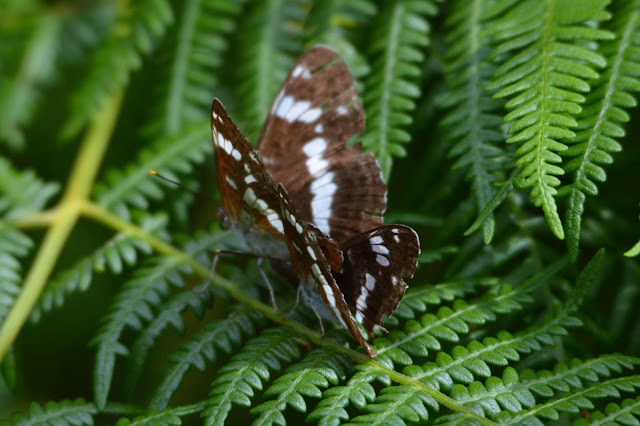







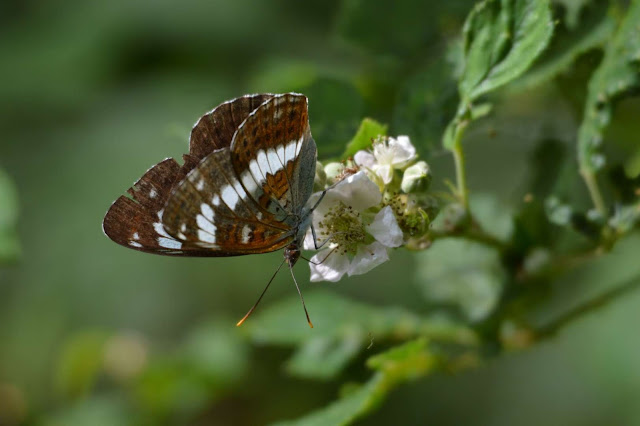









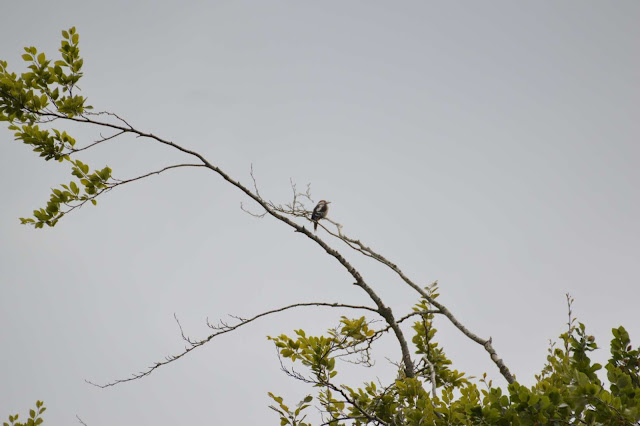






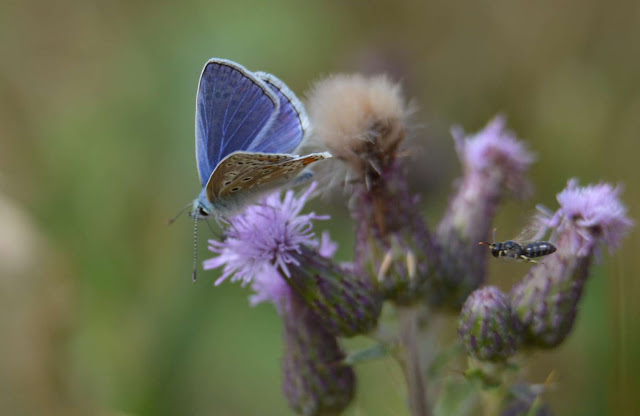












































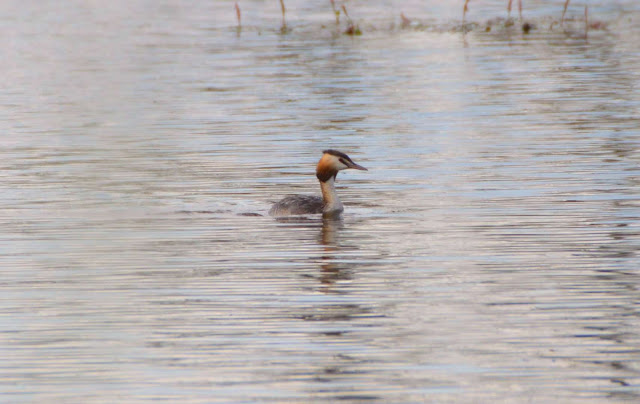


Wonderful, just wonderful 👍🏻😎
ReplyDeleteThanks mate. Really kind. And thanks again for sharing :)
DeleteBeautiful,as always :)
ReplyDeleteThank you Tessa and for taking the time to read it :) x
Delete